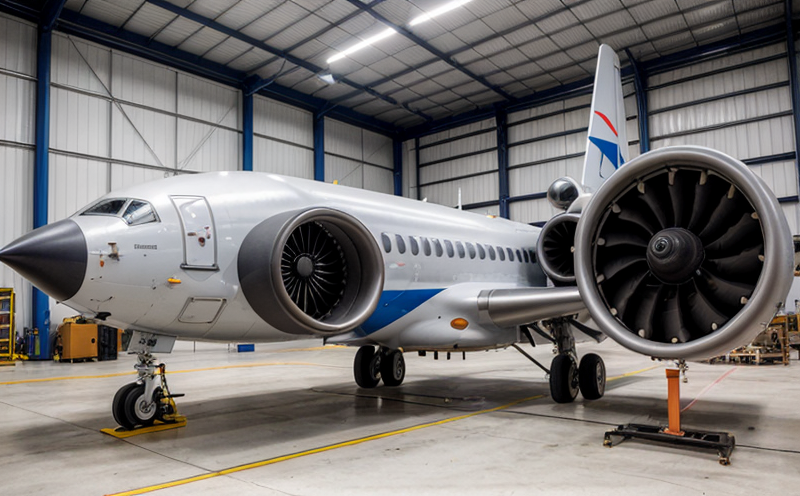Sonic Boom Impact Testing
The phenomenon of sonic boom has long been a subject of interest and concern within the aerospace and defense sectors. Sonic boom occurs when an aircraft travels at supersonic speeds, creating pressure waves that can be heard as a loud boom by people on the ground. The impact of these booms is significant, affecting not only human populations but also physical environments. In this context, sonic boom impact testing plays a crucial role in ensuring the safety and compliance of aerospace products.
Our laboratory offers comprehensive sonic boom impact testing services to help clients understand the effects of supersonic travel on various materials, structures, and environments. This service is essential for manufacturers aiming to meet international standards and regulations related to sonic boom generation and mitigation.
The testing process involves simulating the conditions under which a sonic boom would be produced in real-world scenarios. Specimen preparation typically includes selecting appropriate materials that represent structural components of aircraft or other relevant structures. Instrumentation plays a critical role, with advanced acoustic sensors and pressure gauges used to capture data on sound intensity, frequency distribution, and propagation.
Once the test is conducted, detailed reports are generated, providing insights into how different materials respond to sonic boom pressures. These reports serve as valuable tools for design modifications and compliance verification. Our testing capabilities adhere to international standards such as ISO 146-3:2019, which governs acoustic environment requirements for commercial aircraft interiors.
By leveraging our expertise in this area, clients can gain a deeper understanding of sonic boom impacts, enabling them to make informed decisions regarding product design and material selection. This knowledge is not only beneficial for meeting regulatory requirements but also contributes to the advancement of sustainable aerospace technology.
Why It Matters
The importance of sonic boom impact testing cannot be overstated, especially in an era where environmental sustainability and public safety are paramount. Sonic booms can cause significant disturbances, including loud noises that may lead to sleep disruption, stress, and even health issues among nearby populations. Therefore, understanding the effects of these booms is critical for the aerospace industry.
Our testing services provide essential data on how different materials behave under sonic boom pressure. This information helps manufacturers design quieter aircraft, which in turn reduces noise pollution and enhances quality of life for communities near airports or flight paths. Compliance with international standards ensures that products meet stringent requirements set by regulatory bodies worldwide.
The insights gained from our testing can also contribute to the development of more sustainable aerospace technologies. By minimizing sonic boom impacts, we support efforts towards greener aviation practices. Furthermore, this knowledge is vital for ensuring public safety and fostering trust between industries and communities.
International Acceptance and Recognition
- ISO 146-3:2019 – This standard specifies the acoustic environment requirements for commercial aircraft interiors, including those related to sonic boom impacts.
- American Society for Testing and Materials (ASTM) – ASTM standards provide guidelines on testing methods applicable to aerospace materials exposed to sonic booms.
- Institute of Electrical and Electronics Engineers (IEEE) – IEEE publications contribute to the understanding of electromagnetic compatibility issues associated with supersonic flight conditions.
- European Committee for Standardization (CEN) – CEN standards ensure harmonized technical specifications across Europe, including those relevant to aerospace acoustics.
The acceptance and recognition of these international standards are crucial in ensuring that our sonic boom impact testing meets the highest global benchmarks. Compliance with such standards not only enhances credibility but also facilitates smoother regulatory processes for clients operating internationally.
Environmental and Sustainability Contributions
Sonic boom impact testing contributes significantly to environmental sustainability by promoting quieter aircraft designs that minimize noise pollution. Reducing sonic boom impacts helps protect ecosystems, wildlife habitats, and human health in areas frequented by supersonic flights.
The data we provide through our tests enables manufacturers to optimize material choices for better sound absorption properties, ultimately leading to more sustainable aerospace practices. By adhering to international standards and continuously improving testing methodologies, we strive to contribute positively to the environmental footprint of aviation.
In addition to noise reduction, sonic boom impact testing supports broader sustainability goals by driving innovation in lightweight materials that offer enhanced structural integrity without compromising on performance or energy efficiency. This aligns with global initiatives aimed at reducing carbon emissions and fostering a greener future for air travel.





